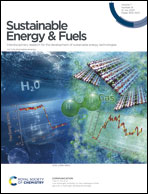N-doped Mo2C particles as a cathode catalyst of asymmetric neutral-alkaline microbial electrolysis cells for hydrogen production†
Abstract
The emerging microbial electrolysis cell (MEC) has great potential for energy recovery from wastewater as hydrogen, while the application of MECs faces challenges of expensive cathodic catalysts and unfavorable neutral electrolytes for the hydrogen evolution reaction (HER). This work synthesizes nitrogen-doped Mo2C particles (Mo2C/N) via a simple and cost-effective pyrolysis route. Mo2C/N-900 shows excellent electrocatalytic activity and durability in a pH-varied electrolyte such as alkaline, neutral and acidic, particularly under alkaline conditions (e.g. 1.0 M KOH) where the overpotential@10 mA cm−2 is only 149 mV, delivering a Tafel slope of 55.7 mV dec−1, which is comparable to that of commercial Pt/C catalysts. An asymmetric neutral-alkaline microbial electrolysis cell with MoC/N as the cathode catalyst is developed for H2 production. Compared to the traditional symmetric neutral MEC, the system requires an applied voltage of 0.8 V to achieve a current density of ∼14.0 A m−2 at a H2 generation rate of 103.0 L m−2 d−1, indicating promising potential of the Mo2C/N electrocatalyst to be applied in MEC devices for H2 generation.



 Please wait while we load your content...
Please wait while we load your content...